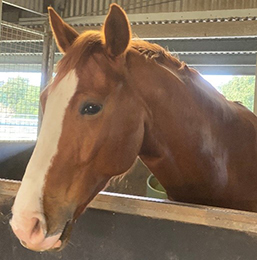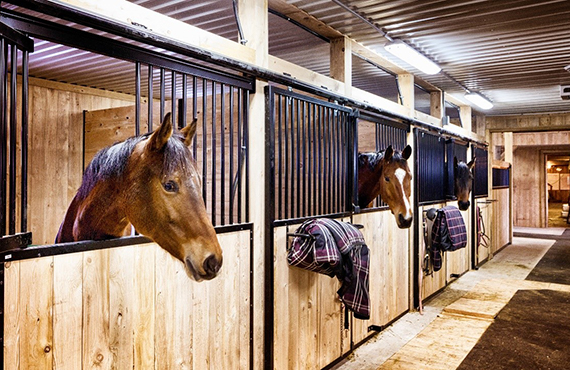
Fire safety in stables
Introduction

- Stable fires occur frequently and can cause severe injury or death to both horses and people.
- Fire can grow rapidly and is extremely dangerous.
- Controlling fire is best left to professional firefighters.
- The following recommendations will help to reduce the risk of fires occurring in stables.
- The information is for general guidance only. It is essential that you seek professional advice on design and construction of stables from technical experts to ensure compliance with current government building regulations, which are referenced below.
Stable construction
New stable construction | Existing stables |
|---|---|
As with any new building, construction of stables must comply with the Australian building code in place at the time. The current building code is the National Construction Code (NCC), previously known as the Building Code of Australia (BCA).
|
|
Fire exits
New stable construction
Refer to the NCC for minimum requirements for the number, location and size of fire exits.
The following general recommendations should also be considered:
- Stable doors must be wide enough to allow horses to be easily removed in the event of a fire
- Individual stable doors should be at least 1.3 metres wide
- Aisle exits should be at least two metres wide
- In large stable complexes sliding doors, maintained in good working order, are preferable to swinging doors (as swinging doors may block aisles)
- Swing doors should open out of the stall, swing through 180° and latch open securely
- Central aisles should be at least two metres wide
- In a stable complex, more than one exit should be available to remove horses quickly
- Larger stable complexes should incorporate enough exits to allow all horses to be removed quickly
- An exit sign should be erected above each exit point.
Ventilation
New stable construction | Existing stables |
|---|---|
|
|
Safe storage of feed and bedding
- Straw, hay and other feeds burn easily and should be stored away from stables
- Storage of these materials in a loft in the stable is unsafe as it creates a significant fire hazard
- Hay fires can be caused by sparks from machinery, discarded burning matches and cigarettes but also from spontaneous combustion, where moist hay generates enough heat to burn
- Find out more about the risks associated with spontaneous combustion of hay.
Tack rooms
- Tack rooms in or near stable complexes are a common source of stable fires due to the location of heaters and cooking facilities in these rooms.
- Where possible, tack rooms should be situated away from the stable complex.
| New stable construction | Existing stables |
|---|---|
| Existing stables should be compliant with the NCC as at the time they were constructed – and again these become “general recommendations
|
Electrical wiring
| New stable construction | Existing stables |
|---|---|
|
|
Fire detection devices
- A fire detection device can be an effective tool to give early warning of fire.
| New stable construction | Existing stables |
|---|---|
|
|
Firefighting equipment
New stable construction
Refer to the NCC classification of the new building for firefighting equipment requirements, including the number and type of fire hoses necessary.
The following general recommendations should also be considered:
- Fire hoses should always be kept in good working order. Fire hoses should be located outside the stable building.
- Fire hoses should reach and deliver water to all stables.
- Large stable complexes should be provided with wide bore high-pressure hoses stored on fire hose reels.
- The water supply should be adequate for the fire hoses installed.
- Fire extinguishers should be placed in practical, easy-to-access positions.
- Staff should be given the opportunity to practice using fire hoses and should be familiar with other firefighting equipment installed such as extinguishers.
- Signage should be erected indicating the location of firefighting equipment and external watering points.
Personnel
- Cigarettes are a common source of fires.
- Post and enforce a NO SMOKING policy in and around stables and feed storage areas.
- If smokers do frequent the stable, provide them with a smoking area away from the stable that is equipped with a receptacle for butts and matches.
Stable cleaning and surrounds
- Keep the stable clean and free of cobwebs, chaff, and dust, which are easily combustible and make excellent fuel sources.
- Keep the grass mowed and the weeds down around stables to eliminate any dried plant material fuel source.
- Ensure there is good accessibility to the property and stable for large, heavy rescue vehicles should a fire response be required.
- The ground around all stable and other buildings should be compacted or sturdy enough to support the weight of heavy equipment, such as a fire truck.
Fire plan
- Prepare a fire plan for the stables. The plan should include a simple diagram of the complex, which should be displayed both inside and outside the stables. The diagram should indicate:
- exit points
- an assembly point well beyond the stable building
- location of fire extinguishers
- location of external watering points
- location of First Aid equipment.
Practise stable evacuation drills
- In a fire emergency, the time available to safely remove horses may be as little as a few minutes.
- By practicing evacuation drills with all horse handlers, both horse and handler can prepare for emergency situations.
- Teach the horses to walk out with their eyes covered and accustom horses to loud noises that simulate alarms and sirens.
- Be aware that if horses are reluctant to walk blind-folded during the drills, they will be even more reluctant during an emergency.
Further information
For further information on fire safety, including fire evacuation plan resources, please visit:
Find further information on preparing for emergencies and natural disasters.
The assistance of the Community Safety Directorate at Fire and Rescue New South Wales in the development of this guideline is gratefully acknowledged.
Published: September 2020


